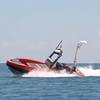In a recent Special Edition of its newsletter, the American Shipbuilding Association said top priority should be given to the USCG Deepwater Project. Following are some direct excerpts from ASA's newsletter:
"The Integrated Deepwater Systems Capabilities Replacement Project is the most important and vital acquisition in the history of the USCG. The Deepwater project is the replacement and modernization of the USCG's current Deepwater assets - some of which rely on 1950s technology - with a 21st century integrated system of ships, aircraft and command, control, communications, computers, intelligence, surveillance and reconnaissance equipment.
Out of the USCG's 41 high and medium cutters, approximately 30 - or 70 percent - were built more than 25 years ago and have already completed one fleet modernization. The USCG estimates in FY 97 it spent about $1.3 billion in personnel, maintenance and other costs related to the operation of its fleet.
Through the use of innovative technology, the USCG seeks to replace its aging fleet with a smaller 'system of systems,' which does not entail a direct one for one platform replacement of assets. The Deepwater project would reduce total ownership costs, including research and development, design and engineering, acquisition and life-cycle operation and support, with a modern system that would require fewer personnel to operate and maintain."
The USCG Deepwater Project continues the teaming trend toward procurement - as seen most recently in the bid and award of major USN contracts - which results in shipyards, equipment makers, systems integrators, and in this case, the aircraft industry aligned in teams which study the project and make comprehensive bids to win the complete package.
In August of 1998, in fact, USCG awarded three teams with $7 million each to develop proposals. The proposals could include replacing existing ships, aircraft and other equipment, upgrading them, or some combination of the two. Besides submitting proposals, the contracts will be required to provide other products such as cost estimates for implementing their proposals, a schedule for acquiring or upgrading any new ships and aircraft, and an implementation plan for integrating the new or upgraded equipment to the USCG.
It is this teaming competition, and the advanced stage of bid preparation, which troubles GAO most about the project. GAO found the USCG justification for the Deepwater Project underestimated the useful life of many ships and aircraft in the deepwater fleet. It also concluded the USCG did not conduct a thorough analysis of the capabilities of current assets, and GAO was not able to validate the information on estimated future demand.
In fact, in its recommendations, GAO has asked the USCG expedite the issuance of information regarding the condition and capabilities of its fleets, while simultaneously asking the USCG to evaluate if the $500 million per year figure is indeed realistic given the current fleet and funding scenarios.
The USCG's current Deepwater fleet consists of 92 ships and 209 aircraft.
In a recent Special Edition of its newsletter, the American Shipbuilding Association said top priority should be given to the USCG Deepwater Project. Following are some direct excerpts from ASA's newsletter:
"The Integrated Deepwater Systems Capabilities Replacement Project is the most important and vital acquisition in the history of the USCG. The Deepwater project is the replacement and modernization of the USCG's current Deepwater assets - some of which rely on 1950s technology - with a 21st century integrated system of ships, aircraft and command, control, communications, computers, intelligence, surveillance and reconnaissance equipment.
Out of the USCG's 41 high and medium cutters, approximately 30 - or 70 percent - were built more than 25 years ago and have already completed one fleet modernization. The USCG estimates in FY 97 it spent about $1.3 billion in personnel, maintenance and other costs related to the operation of its fleet.
Through the use of innovative technology, the USCG seeks to replace its aging fleet with a smaller 'system of systems,' which does not entail a direct one for one platform replacement of assets. The Deepwater project would reduce total ownership costs, including research and development, design and engineering, acquisition and life-cycle operation and support, with a modern system that would require fewer personnel to operate and maintain."
The USCG Deepwater Project continues the teaming trend toward procurement - as seen most recently in the bid and award of major USN contracts - which results in shipyards, equipment makers, systems integrators, and in this case, the aircraft industry aligned in teams which study the project and make comprehensive bids to win the complete package.
In August of 1998, in fact, USCG awarded three teams with $7 million each to develop proposals. The proposals could include replacing existing ships, aircraft and other equipment, upgrading them, or some combination of the two. Besides submitting proposals, the contracts will be required to provide other products such as cost estimates for implementing their proposals, a schedule for acquiring or upgrading any new ships and aircraft, and an implementation plan for integrating the new or upgraded equipment to the USCG.
It is this teaming competition, and the advanced stage of bid preparation, which troubles GAO most about the project. GAO found the USCG justification for the Deepwater Project underestimated the useful life of many ships and aircraft in the deepwater fleet. It also concluded the USCG did not conduct a thorough analysis of the capabilities of current assets, and GAO was not able to validate the information on estimated future demand.
In fact, in its recommendations, GAO has asked the USCG expedite the issuance of information regarding the condition and capabilities of its fleets, while simultaneously asking the USCG to evaluate if the $500 million per year figure is indeed realistic given the current fleet and funding scenarios.
The USCG's current Deepwater fleet consists of 92 ships and 209 aircraft.
Sponsored Content
Protect Your Crew. Exceed Weld Standards.

MSC Sets a New Standard for Time Off in 2025, Plus Earn a $44,345 Bonus as an Able Seaman!

Subscribe for
Maritime Reporter E-News
Maritime Reporter E-News is the maritime industry's largest circulation and most authoritative ENews Service, delivered to your Email five times per week








